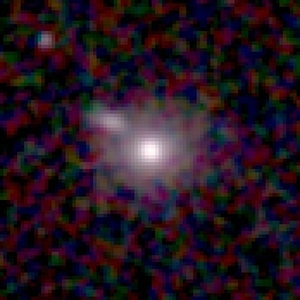Markaryan 421
| Galaxy Markaryan 421 |
|
|---|---|

|
|
| Blasar Markarjan 421, taken by 2MASS | |
| AladinLite | |
| Constellation | Big Bear |
|
Position equinox : J2000.0 , epoch : J2000.0 |
|
| Right ascension | 11 h 04 m 27 s |
| declination | + 38 ° 12 ′ 32 ″ |
| Appearance | |
| Morphological type | S ?; BLLAC |
| Brightness (visual) | 13.5 likes |
| Brightness (B-band) | 14.0 mag |
| Angular expansion | 0.8 ′ × 0.6 ′ |
| Physical data | |
| Redshift | 0.030021 ± 0.000080 |
| Radial velocity | 9000 ± 24 km / s |
| distance | approx. 500 million ly |
| history | |
| Catalog names | |
| UGC 6132 • PGC 33452 • Mrk 421 • | |
Markarjan 421 (Mrk 421, also Mkn 421) is a blasar in the constellation Great Bear , which was first systematically observed by Benjamin Markarjan . It is about 500 million light years from Earth. In its center there is a black hole , the resulting jet beam has almost the speed of light and is directed towards earth.
Markarjan 421 has been systematically observed with HEGRA on La Palma since 1995 . At the beginning of 2001 the highest activity to date was recorded.
Markarjan 421 belongs with Markarjan 501 to the closest and most powerful high-energy gamma ray sources. Both are important objects for testing new theoretical physical approaches.
